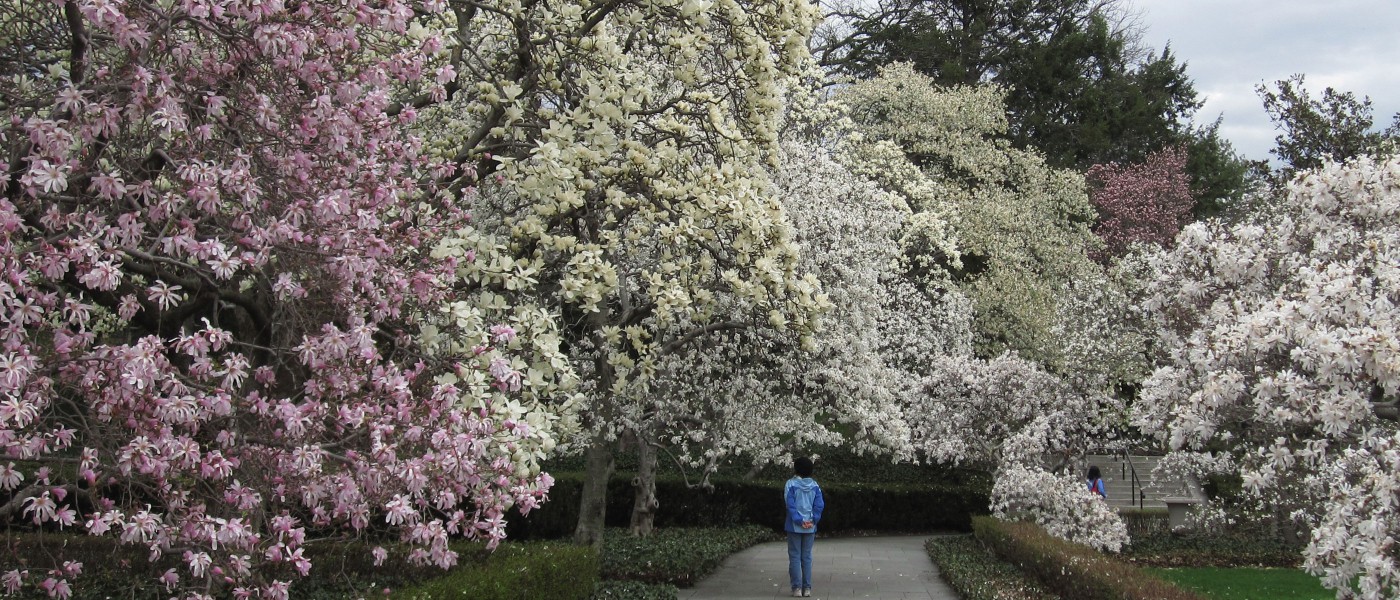Bloom Alert: Magnolia Plaza
There is no better place to experience the breadth of this genera than Magnolia Plaza, where you can see examples of about 30 different species, hybrids, and cultivars. This collection showcases the rich history and lineage of one of our most beautiful flowering ornamentals. The early-blooming specimens have just blossomed, with later ones to follow over the next several weeks. Read on to learn a little more about some of these magnolias—and be sure to come see for yourself.
Yulan Magnolia
The yulan magnolia (Magnolia denudata) is one of first in the collection to bloom. It has been cultivated as an ornamental tree for more than 1000 years—in China, Buddhist monks planted it in temple gardens as far back as the T’ang Dynasty (CE 618–907). The flower had particular significance as a symbol of purity and openness.
The yulan magnolia is known as a precocious bloomer, which means the flowers appear before the leaves. Its specific epithet, denudata, is a reference to this phenomenon—it means “naked” or “barren.” The three yulan specimens here were part of the inaugural Magnolia Plaza plantings in 1932.
Saucer Magnolia
Easily the most common ornamental magnolia, the saucer magnolia (Magnolia × soulangeana) is also a precocious bloomer. Its flowers are absolutely stunning. They feature varying shades of white, pink, and purple and reach up to eight inches across, depending on the cultivar (of which there are now more than 100). This relatively old hybrid was developed in 1820 by French plantsman Étienne Soulange-Bodin when he crossed the yulan (M. denudata) and another Asian species, the mulan magnolia (M. liliiflora). BBG has a dozen saucers on display in Magnolia Plaza.
Magnolia × brooklynensis ‘Hattie Carthan’
In years past, BBG played an important role in magnolia breeding and produced produced a number of significant hybrids. In 1968, breeder Evamaria Sperber developed the hybrid group Magnolia × brooklynensis, which was the first successful cross of an Asian and an American magnolia—the mulan and the American cucumber tree (Magnolia acuminata). Others have repeated the cross to form new cultivars, but none are more near and dear to BBG's collection than the ones developed here.
More: Eight Magnolia Hybrids Bred by Brooklyn Botanic Garden
Among them is a late-blooming “Brooklyn yellow,” the ‘Hattie Carthan’ magnolia (Magnolia × brooklynensis ‘Hattie Carthan’) that was developed here and introduced in 1989. A new specimen was just reintroduced to Magnolia Plaza last year. Its flowers are a unique greenish yellow with magenta veins running up each of its tepals. Watch for it to flower in mid-May, at the same time that its leaves unfurl. Its later flowering time makes it much less susceptible to late frosts than precocious bloomers. This hybrid’s namesake, Hattie Carthan, was a Bed-Stuy resident and community activist, founder of Magnolia Tree Earth Center in Brooklyn, and onetime BBG Board of Trustees member. A more mature specimen can be found just south of the Shakespeare Garden.
Magnolia ‘Elizabeth’
The ‘Elizabeth’ magnolia (Magnolia ‘Elizabeth’), also developed here by Sperber and introduced in 1977, may be the most famous of the BBG magnolias. It’s the first precocious yellow hybrid and a cross between the yulan and the American cucumber tree. Its name honors Elizabeth Van Brunt, a BBG benefactor.
Magnolia ‘Lois’
Further work on precocious yellow hybrids led to the introduction of the ‘Lois’ magnolia (Magnolia ‘Lois’) in 1998. This later bloomer has deep yellow flowers that hold their color longer than ‘Elizabeth’. ‘Lois’ was, in fact, crossed with a sibling of ‘Elizabeth’. This work was done by another BBG plant breeder, Lola Koerting.
Magnolia ‘Lois’ was named in honor of Lois Carswell, former chair of BBG’s Board of Trustees and cochair of our annual Plant Sale, who passed away last fall. There are two ‘Lois’ magnolias in Magnolia Plaza.


